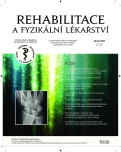Relation of the Heel Valgosity, Typology and Biomechanics of the Foot in Children
Authors:
L. Honzíková 1,2; Z. Svoboda 1; M. Janura 1; J. Rosický 2; E. Martinasková 1
Authors‘ workplace:
Katedra přírodních věd v kinantropologii, FTK UP Olomouc
vedoucí prof. RNDr. M. Janura, Dr.
1; Ortopedická protetika Frýdek-Místek
vedoucí Ing. J. Rosický, CSc.
2
Published in:
Rehabil. fyz. Lék., 20, 2013, No. 2, pp. 71-76.
Category:
Original Papers
Overview
The safe and economically undemanding walk requires a correct function of the foot. The evaluation of the foot condition and determination of the relations among selected mechanic parameters of the foot should be therefore performed already from the preschool age. The basic biomechanics methods, which serve in the analysis of the foot load include the use of pressure plates. In evaluating the position and load of the foot in walking we must consider relations among individual segments of the foot and their relation to other segments of lower extremity. The study encompassed 44 children (mean age 5.15 ± 1.45 year) evaluated for the position of the posterior hindfoot against shank and the position of forefoot to hindfoot in resting position and during walk.
For measurement of the foot load in contact with the pad, the authors used a 2m pressure plate footscan. In the observed group of children, the static heel valgosity prevailed, followed by neutral position of the hindfoot in combination with the varous forefoot. The deviation of the foot axis medially in relation to the direction of motion proved to be more frequent in children with static heel valgosity.
Keywords:
gait, foot load, heel valgosity, forefoot, hindfoot, biomechanics
Sources
1. ADAMEC, O.: Plochá noha v dětském věku: Diagnostika a terapie. Pediatr. pro Praxi, roč. 5, 2005, č. 4, s. 194-196.
2. BRUCE, R. W. Jr.: Torsional and angular deformities. Pediatr. Clin. North Am., roč. 43, 1996, č. 4, s. 867-881.
3. COLL-BOSCH, M. D., VILADOT, A., SUSO, S.: Follow-up study of flat foot in children. J. Bone Joint Surg. Br., roč. 85, 2003, suppl. III, s. 268.
4. D’AMICO, J. C.: Developmental flatfoot. Clin. Podiatry, roč. 1, 1984, č. 3, s. 535-546.
5. D’AOUT, K., AERTS, P.: The evolutionary history of the human foot. In: D’AOUT, K., LESCRENIER, K., VAN GHELUWE, B., DE CLERCQ, D.: Advances in plantar pressure measurements in clinical and scientific research. Maastricht: Shaker Publishing BV, 2008, s. 44-68.
6. DUNGL, P. a kol.: Ortopedie. Praha, Grada Publishing a.s., 2005.
7. EIS, E.: Ortopedie. Praha, SPN, 1976.
8. GARCÍA-RODRÍGUEZ, A., MARTÍN-JIMÉNEZ, F., CARNERO-VARO, M., GÓMEZ-GRACIA, E., GÓMEZ-ARACENA, J., FÉRNANDEZ-CREHUET, J.: Flexible flat feet in children: A real problem? Pediatrics, roč. 103, 1996, č. 6, s. 1-3.
9. HARRIS, J. E., VANORE, J. V., THOMAS, J. L., KRAVITZ, S. R., MENDELSON, S. A., MENDICINO, R. W., SILVANI, S. H., GASSEN, S. C.: Diagnosis and treatment of pediatric flatfoot. J. Foot Ankle Surg., roč. 43, 2004, č. 6, s. 341-373.
10. HERNANDEZ, A. J., KIMURA, L. K., LARAYA, M. H. F., FÁVARO, E.: Calculation of staheli’s plantar arch index and prevalence of flat feet: A study with 100 children aged 5-9 years. Acta Ortop. Bras., roč. 15, 2007, č. 2, s. 68-71.
11. JONES L. J., TODD W. F.: Abnormal biomechanics of flatfoot deformities and related theories of biomechanical development. Clin. Podiatr. Med. Surg., roč. 6, 1989, č. 3, s. 511-521.
12. PERRY, J.: Gait analysis: Normal and pathological function. Thorofare, Slack Incorporated, 1992.
13. PETTENGILL M. J., JAY R. M.: Inserts offer a new angle on pediatric flat foot treatment. BioMech. Arch., 2006.
14. PFEIFFER, M., KOTZ, R., LEDL, T., HAUSER, G., SLUGA, M.: Prevalence of flat foot in preschool-aged children. Pediatrics, roč. 118, 2006, č. 2, s. 634-639.
15. PRATT, D. J.: Functional foot orthoses. Foot, roč. 5, 1995, č. 3, s. 101-110.
16. PRATT, D. J., SANNER, W. H.: Paediatric foot orthoses. Foot, roč. 6, 1996, č. 3, s. 99-111.
17. ROSE, G. K., WELTON, E. A., MARSHALL, T.: The diagnosis of flat foot in the child. J. Bone Joint Surg. Br., roč. 67, 1985, č. 1, s. 71-78.
18. ROOT, M. L., ORIEN, W. P., WEED, J. H.: Abnormal motion of the foot. In: ROOT, M. L., ORIEN, W. P., WEED, J. H.: Normal and abnormal function of the foot. Los Angeles, Clinical Biomechanics, roč. 2, 1977, s. 295-348.
19. SCHERER, P. R.: Treatment of pediatric flexible flatfoot with functional orthoses. Pod. Mgmt., roč. 27, 2008, č. 7, s. 129-134.
20. STANLEY, D.: Paediatric foot injuries. Foot, roč. 8, 1998, č. 1, s. 9-16.
21. TALLEY, W., GOODEMOTE, P., HENRY, S. L.: Managing intoeing in children. Am. Fam. Physician, roč. 84, 2011, č. 8, s. 937-944.
22. TAX, H. R.: Conservative treatment of flatfoot in the newborn. Clin. Podiatr. Med. Surg., roč. 6, 1989, č. 3, s. 521-536.
23. VALMASSY, R. L.: Clinical biomechanics of the lower extremities. St. Louis, Mosby, Inc., 1996.
24. VAŘEKA, I., VAŘEKOVÁ, R.: Kineziologie nohy. Olomouc, Univerzita Palackého, 2009.
25. WALL, E. J.: Practical primary pediatric orthopedics. Nurs. Clin. North. Am., roč. 35, 2000, č. 1, s. 95-113.
26. WENGER, D., MAULDIN, D., SPECK, G., MORGAN, D., LIEBER, R. L.: Corrective shoes and inserts as treatment for flexible flatfoot in infants and children. J. Bone Joint Surg. Am., roč. 71, 1989, č. 6, s. 800-810.
Labels
Physiotherapist, university degree Rehabilitation Sports medicineArticle was published in
Rehabilitation & Physical Medicine

2013 Issue 2
Most read in this issue
- Relation of the Heel Valgosity, Typology and Biomechanics of the Foot in Children
- What Should Physiotherapist Know about Carpal Instability?
- McKenzie Method in Combination with (as a part of) the Classic Physiotherapy in the Treatment of Patients with Chronic Pain in the Cervical Region of the Spine
- Quantifying the Influence of Vacuum-compression Therapy on the Direct Increase of Oxygen Supply in the Treated Extremity
